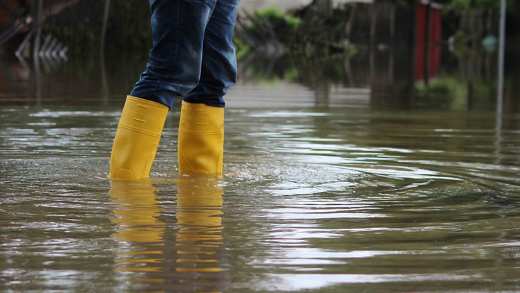10 things you should do immediately when there’s a flood warning
When a flood warning sounds it means that flooding is expected and you need to act fast.

Before a flood
1. Move things to a safe spot
Some of your most treasured household items could be at risk of water damage and electric items can become an electrocution risk if they come into contact with water. Electrical items like TVs should be moved above ground level, while heavier items like fridges and freezers could be raised up on bricks if possible, to keep the electrical circuits above potential flood level and make the property as safe as possible.
We also recommend moving furniture, valuables, and important documents to somewhere safer. Only move things you can easily manage yourself or ask for help, you wouldn’t want to injure yourself for the sake of an armchair.
If you have a vehicle then move it to higher ground to avoid the floodwaters.
2. Try to stop water from getting in
Thwart the flood by laying sandbags at entry points such as doors. If you don’t have any to hand, then a pillowcase or plastic bag filled with garden soil can be used as an alternative. You should also put plugs in sinks and baths and weigh them down with something heavy to prevent sewage water backflowing into your home. And remember, shut and lock all windows and doors.
3. Alert your neighbours
Make sure everyone knows there is a flood on the way – especially older or unwell neighbours.
4. Grab some essentials
By this point you should have moved your most precious items out of the reach of flood water, but you’ll want to keep more practical things closer at hand. Pack essentials into a ‘flood kit’ – you’ll want things like a torch and batteries, spare mobile phone, essential medicine or a first aid kit, important personal documents including your passport and insurance documents, blankets, and waterproof clothing.
During a flood
5. Turn off your gas, electricity, and water supplies
This can prevent damage to the systems and reduce the risk of gas leaks, electrocution, and a polluted or depleted water supply. If you’re unsure on how to do this, then ask your supplier in advance – you can mark taps and switches with stickers to help you remember.
6. Avoid the water
This may be stating the obvious, but flood water is dangerous as it can be fast flowing and contaminated with sewage. Avoid walking or driving through it and wash your hands thoroughly if you touch it.
7. Evacuate when told to do so
Listen to the advice of the emergency services. If they tell you to evacuate your home, then you should immediately.
After a flood
8. Contact your insurer as soon as possible
If you need to claim on your home insurance, get the process started immediately. Identify damaged items - make a list and take photos of any damage and the flood water line if you can – this makes it easier to assess the damage and speed up your claim.
Find out more about how to make a claim and what you need.
We know how difficult a time it can when your home is hit by a flood, and we’ll be by your side through the claims process and beyond. Insurers can usually help with the drying out process for your home, suggestions so you can minimise further damage, and help with emergency accommodation, if needed.
9. Avoid touching electrics
Plugs, sockets, and electrical appliances could have been damaged by the water and can be dangerous. Wait until someone who’s qualified tells you they’re ok to use again.
10. Dry out your house
If water has come into your home, then you need to dry it out – there are a number of professional services out there that can help with this. Dehumidifiers can also help speed up the process.



